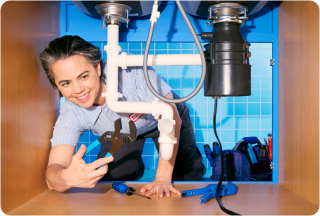Is Your High Water Bill Due to Plumbing Problems?

If you're wondering why is my water bill so high, then checking plumbing fixtures for leaks is a must. Leaky faucets and running toilets can really cost you.


If you're wondering why is my water bill so high, then checking plumbing fixtures for leaks is a must. Leaky faucets and running toilets can really cost you.
Have you ever experienced sticker shock from an unusually high water bill and wondered why the amount suddenly skyrocketed out of the blue?
In most cases, a high water bill is caused by a leak somewhere in your plumbing system.
With a little detective work and ingenuity, you may be able to locate the source of the leak and fix it yourself. For more serious plumbing issues, you may need a plumbing professional.
The first step is to check if you actually leaking, as there are other reasons for a high water bill, including overwatering the lawn, frequent use of your washing machine, or adding another person to your household.
To determine if you have a leak in your system, check your water meter:
Inside your house, there are several sources of possible plumbing issues to could explain your high water bill. A leaky toilet is the most common culprit, contributing to about 90 percent of indoor leaks. A leaking or running toilet can waste up to 200 gallons a day or 1,400 gallons in a week.
Here’s how to determine if a leaky toilet is the source of the problem:
The cause of the leak is often a faulty or worn-out flapper (flush valve) in the toilet’s tank. You can get a replacement at your hardware store, and installation is easy. Just leave enough slack in the chain to allow the flapper to do its job.
Thinking about coverage?
Security for your home. Protection for your budget.
Leaky faucets and fixtures are other possible sources of your high water bill. According to the Environmental Protection Agency, a leaky faucet dripping one drop per second wastes up to 3,000 gallons of water a year; a dripping shower head wastes up to 500 gallons per year. The most common source of a faucet leak is a faulty washer in the faucet handle. To remedy it, shut off the water, unscrew the handle, and replace the washer.
Most leaky shower heads can be fixed by using pipe tape and a wrench to ensure a snug fit. If you have to replace either a faucet or shower head, try to replace it with one bearing the WaterSense label. The EPA website can help you find these and other water-efficient products.
Beyond the obvious sources of indoor plumbing problems, look for leaks around the baseboards and walls near your plumbing fixtures. Mildew or mold, darkened surfaces or puddles of water may occur near leaks. If the leak is inside the wall, you might need to call in a pro to address that issue.
Outside your house, the most common causes of a water leak are your irrigation system or a cracked or loose joint in one of the underground pipes feeding water into your house. For either of these, you will need to call in a plumber versus taking a DIY approach.
Once you troubleshoot the problem, you'll be able to take the next steps for getting it fixed. If you want to be protected from plumbing problems in the future, consider investing in a home warranty to get the coverage you need.
See how a plumbing protection plan can help with covered repairs.

AHS assumes no responsibility, and specifically disclaims all liability, for your use of any and all information contained herein.
Have a plan for your home when things don't go according to plan
Shop Home Warranties